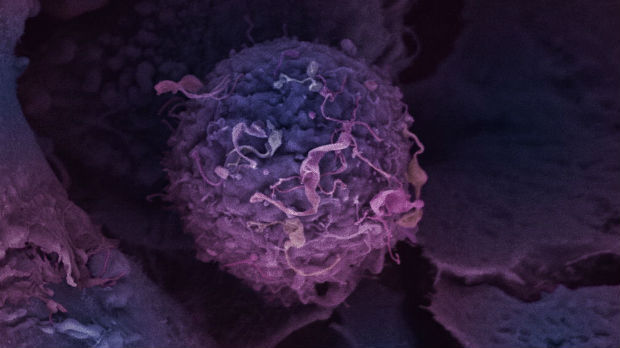Mainstream medicine wants you to depend on mammograms, but early detection of breast cancer is too important.
Breast cancer is the most common cancer in women, with 330,000 women diagnosed with it just in the United States every year. 40,000 women die from it annually.
The most common symptom of breast cancer is a new lump or mass in your breast, and most of them are detected by the women themselves.
That’s what modern medicine and the entire mainstream breast cancer industry is hiding from you, with their emphasis on mammograms.
50% of women over 50 find their lumps. So do 71% of women under 50.
13% of new cases are found by a doctor during an exam.
A study done in Canada of 90,000 women found that, for women aged 40-59, getting mammograms did not even help the women live longer.
Therefore, clearly, the touch of a concerned person is the most effective tool for finding breast cancer early enough to fight it.
Researchers in England have developed a blood test to detect breast cancer five years before it forms a substantial lump. However, that’s years away from commercial availability.
The IvyGene blood test for cancer is now available, so suggest it to your doctor to assist in their diagnosis process.
Mammograms Have Many Problems
They can detect breast cancer, but come with risks.
They expose you to about 0.4 millisieverts of radiation, which is like a weak x-ray. You usually get about three millisieverts every year in background radiation.
The way mammograms compress your breasts can not only hurt but can rupture a tumor if one is present, spreading the cancer.
Also, sometimes you get a false negative because your breast tissue is so dense, the tumor isn’t detected.
And there are also false positives.
MRIs are One Alternative
But they use toxic gadolinium as a contrast dye.
Thermographic Imaging and Ultra Sound are Noninvasive
Thermographic imaging detects the patterns of heat in your breasts, without any pain or radiation.
It’s not a definitive diagnosis but can pick up patterns that indicate you may have a tumor present.
Ultrasound is also an excellent test to help find potential problems.
But these come down to you first detecting a lump through your own breast self-exam.
Your Breast Self-Exam
Do them once a month. If you’re still menstruating, perform it at the end of your cycle.
If you’re postmenopausal, just pick one day every month you’ll remember and do it then.
Lying on your back, in a circular motion, rub your entire breasts with the padding of your fingertips. Go up to your collar bone and over to your armpits, because breast tissue goes that far.
Then do the same self-examination while standing up.
The good news – 80% of breast lumps are benign.
However, if you find anything suspicious, go to your doctor to have it checked out.
Other symptoms to look for:
* Changes to the skin of your breasts
* Peeling or flaking of the skin of your nipples
* Discharge from your nipples
* One breast is larger than the other
* Swelling or redness of your breasts
* Swollen lymph nodes in your armpits
* Pitting of your skin
* The appearance of your nipples changes
* Your breasts are itchy
The Angelina Jolie Solution is Too Extreme
All medical procedures come with risk, especially drastic surgery. You’re safer not undergoing any unnecessary procedures.
Everybody has the BRCA1 and BRCA2 genes, and that’s good because they protect your DNA. They suppress tumors.
However, about 1 in 400 women have a mutated BRCA1 or BRCA2 gene that fails to protect their DNA. About 55%-65% of the women with the BRCA1 gene and 45% of the women with the BRCA2 gene develop breast cancer by age 70.
Notice – those odds are still far from 100%.
Many women with the BRCA1 or BRCA2 mutations do NOT develop breast cancer – and many women without those genes DO develop breast cancer.
Your genes affect the odds, but they do NOT determine your fate.
You Can Put the Odds in Your Favor
While many doctors still have the mindset cancer comes from your genes or just strikes at random, thousands of medical studies show that’s not true.
A healthy lifestyle affects your odds of developing any kind of cancer, and can at least slow down its progression if not prevent it.
Obesity is strongly associated with breast cancer, so lose weight if you need to.
Regular, moderate exercise cuts your cancer risk, so start walking every day.
Losing sleep is associated with a high risk of cancer, so get 7-8 hours every night.
Long term exposure to estrogen affects your breast cancer risk. That includes not only your own natural estrogen, but fake estrogens you’re exposed to from the environment, such as pesticides and bisphenol A, which is in many products made of plastic.
Two Foods Everybody Should Eat Every Day
Ground flaxseeds contain lignans, which are phytoestrogens.
That is, they are similar to estrogen but weaker. Yet they occupy the same estrogen receptors in your cells, so the stronger estrogen and fake estrogens that raise your breast cancer risk cannot get to your cells.
Studies show that women who eat the most soy have a 29% less risk of dying from breast cancer.
This is especially evident in Asia, where soy is commonly eaten – yet few women develop breast cancer.
Whole soybeans are not so available in the United States, but soy milk is in every supermarket, so drink a glass or two daily.
Soy foods activate your BRCA1 and BRCA2 genes, so they protect your DNA, suppressing tumors.
Guys: prostate cancer parallels breast cancer in many ways.
Everybody with breasts or a prostate should eat a tablespoon of ground flaxseeds and a glass of soy milk every day.
Therefore, the best way to protect yourself from breast cancer is to live a healthy lifestyle and to examine your breasts every month.








